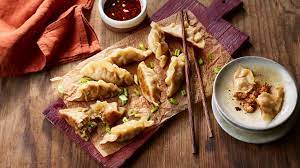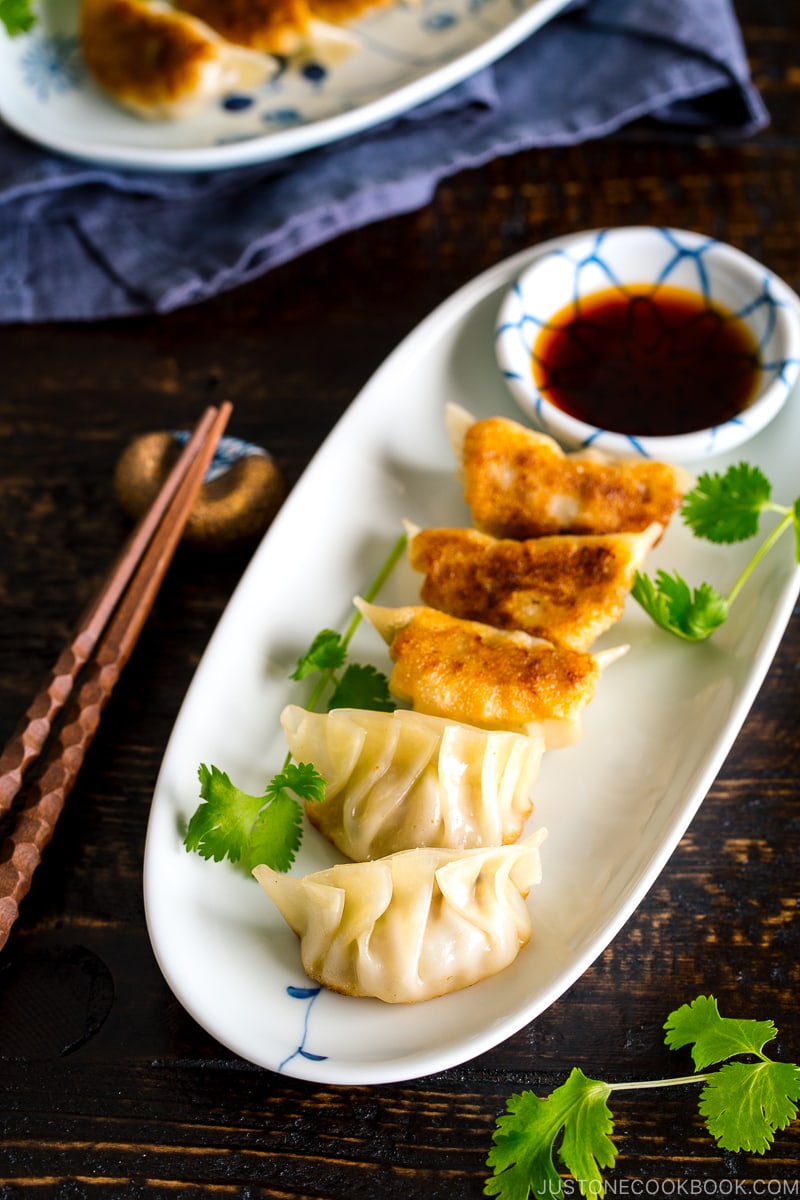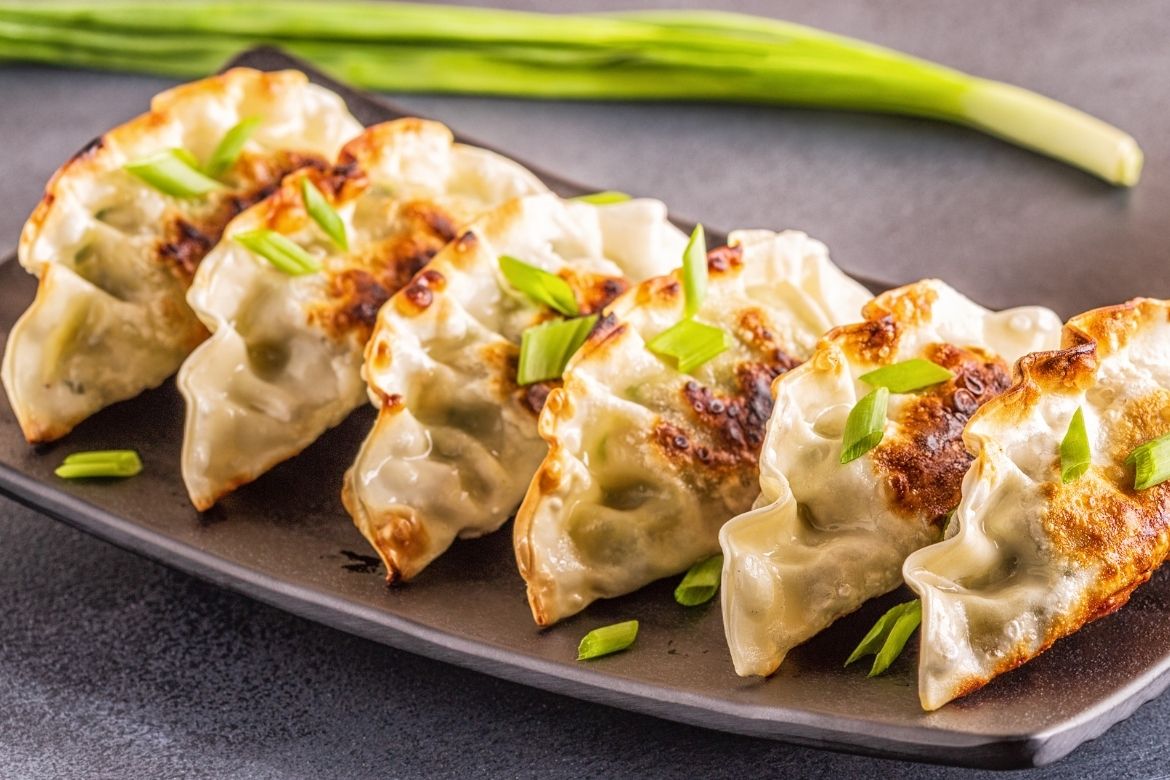Gyoza (Japanese dumplings) is one of those foods that connect people and holds people together. I have so many memories related to gyoza. And the best one is definitely my grandma teaching me how to fold them. We spent whole afternoons making gyoza together.
Although now I make them alone, folding gyoza is one of my favorite activities. I think it is therapeutic. Of course, I never eat them alone. My whole family loves gyoza!
Gyoza are typically white, but this time I used some natural fuchsia hibiscus powder to get this pretty color. You can fill them with whatever you like; I like to make a tofu and veggies filling.
I prefer to make my own homemade wrappers but, of course, you can use store bought wrappers.


Gyoza (Japanese dumplings)
Equipment
- 2 bowl
- 1 chopsticks or a wooden spoon
- 1 cling wrap
- 1 skillet
Ingredients
- 200 grams all purpose flour
- 100 ml boiling hot water
- 1/4 tsp salt
- 1 Tbsp sesame seed oil
- fuchsia Hibiscus powder
- 250 grams firm tofu
- 250 grams napa cabbage
- 50 grams cremini mushrooms
- 1 tsp grated ginger
- 3 Tbsp chopped spring opnions
- 2 Tbsp sesame seed oil
- 1 Tbsp soy sauce
- 1/4 tsp salt
- some white pepper
Instructions
- Place the flour in a large mixing bowl. If you’re using coloring powder add it to the flour and whisk well to combine.
- Boil water and combine with salt. Add boiling hot water to the flour and combine with a pair of chopsticks or a wooden spoon.
- Add sesame seed oil and continue to mix. When it becomes crumbled, use your hands to make a ball. Knead the dough in the bowl, until you pick up all of the dough on the side of the bowl.
- Wrap with a cling wrap and rest for about 30 minutes.
- Remove cling wrap and knead for a few minutes on a lightly floured bench top. When the dough surface becomes smooth, cover with cling wrap again and rest for further 30 minutes.
- Divide the dough into two. Roll out flat on a lightly floured surface to about 1-2 mm with a rolling pin.
- Cut out the dough into a round shape using a 11cm large cookie cutter.
- Finely chop the cabbage, place it in a bowl and add 1 tsp salt to draw out the water. Set aside for 20 minutes.
- Wrap the tofu with paper towels and place it on a plate. Weight it down with a heavy object for 15-30 minutes to drain the water.
- After 20 minutes, squeeze the cabbage with a cloth or by hand.
- Finely grind the tofu and the mushrooms and place them in a bowl.
- Add soy sauce, sesame oil, salt and pepper, chopped spring onions and grated ginger.
- Combine all the ingredients for the filling and fill the dumplings.
- Place a heaping teaspoon of filling in the middle of each dumpling and fold in desired shape.
- To cook the gyoza, pour just enough oil to cover a large skillet (about 1 tsp). Heat the oil over medium heat, add the gyoza.
- When the bottoms get golden brown, add 1/4 cup of water, then immediately cover. Cooke for a couple of minutes o until all the water is evaporated.
- You can freeze the uncooked gyoza. Place them on a baking sheet leaving some space between to keep them from sticking, and put in the freezer. Transfer frozen gyoza into a freezer bag and store in the freezer for up to a month. When you use frozen gyoza, do not defrost. Cook while frozen and steam for extra 1-2 minutes.
Video
Nutritional ingredients of Gyoza (Japanese dumplings)
The nutritional ingredients of Gyoza (Japanese dumplings) can vary depending on the ingredients used in the filling and the cooking method, but here are some of the typical nutritional values for a serving size of 4-5 pieces of pork Gyoza (approximately 100 grams):

- Calories: 200-300
- Protein: 8-12 grams
- Fat: 7-12 grams
- Carbohydrates: 25-30 grams
- Fiber: 1-2 grams
- Sodium: 500-700 milligrams
Note that the nutritional values may vary depending on the filling used. For example, vegetarian or seafood Gyoza (Japanese dumplings) may have different nutritional content compared to pork Gyoza. Additionally, the cooking method can also affect the nutritional values, as pan-fried Gyoza may have a slightly higher fat content than boiled or steamed Gyoza.
Cooking tips Gyoza

Here are some cooking tips for making delicious Gyoza (Japanese dumplings):
- Choose the right wrapper: Make sure to use high-quality Gyoza wrappers that are thin and pliable. Thick or dry wrappers can be difficult to work with and may result in tough and chewy Gyoza.
- Keep the filling moist: To prevent the filling from drying out and becoming tough, make sure to keep it moist by adding a little water or broth to the mixture.
- Don’t overfill the wrapper: When filling the Gyoza wrappers, make sure not to overstuff them, as this can cause the dumplings to burst open during cooking.
- Use a non-stick pan: To ensure that the Gyoza don’t stick to the pan, use a non-stick pan or a well-seasoned cast iron skillet.
- Cook in batches: Don’t overcrowd the pan when cooking Gyoza, as this can cause them to steam rather than fry and result in a soggy texture. Cook them in batches and give them some space in the pan.
- Add water and cover: If you’re pan-frying Gyoza, add a small amount of water (about 1/4 cup) to the pan and immediately cover it with a lid. This will create steam and help cook the dumplings through.
- Check the bottom: When cooking Gyoza, make sure to check the bottom for a crispy, golden-brown crust before removing them from the pan.
- Serve immediately: Gyoza is best served hot and fresh, so make sure to serve them immediately after cooking. Serve them with a dipping sauce of soy sauce, rice vinegar, and chili oil for extra flavor.
FAQs of Gyoza (Japanese dumplings)

Here are some frequently asked questions about Gyoza (Japanese dumplings):
Q: What is Gyoza?
A: Gyoza is a Japanese dumpling that is typically filled with ground meat (usually pork), vegetables, and seasonings, then wrapped in a thin dough wrapper and pan-fried, boiled, or steamed.
Q: Are Gyoza healthy?
A: Gyoza can be a healthy food option if made with lean protein and vegetables, and cooked using healthy methods such as steaming or boiling. However, some Gyoza may be high in sodium and fat if they are fried or made with fatty meat.
Q: How do you make Gyoza wrappers?
A: Gyoza wrappers can be made by mixing wheat flour and water to form a dough, then rolling it out into thin circles using a rolling pin or pasta machine. However, it is more common to buy pre-made Gyoza wrappers from a store.
Q: How do you cook Gyoza (Japanese dumplings)?
A: Gyoza can be cooked by pan-frying, boiling, or steaming. To pan-fry Gyoza, heat a small amount of oil in a non-stick pan over medium-high heat, then add the dumplings and cook until the bottoms are golden-brown.
Add a small amount of water to the pan, cover, and cook until the water has evaporated and the Gyoza are cooked through. To boil or steam Gyoza, simply add the dumplings to a pot of boiling water or a steamer basket and cook until they float to the surface or are cooked through.
Q: What is the difference between Gyoza and Chinese dumplings?
A: Gyoza and Chinese dumplings are similar in that they are both filled with meat and vegetables and wrapped in a thin dough wrapper. However, the filling and seasoning used in Gyoza are typically different from those used in Chinese dumplings, and Gyoza are usually smaller and have a thinner wrapper.
Q: What is the dipping sauce for Gyoza (Japanese dumplings)?
A: The dipping sauce for Gyoza is typically a mixture of soy sauce, rice vinegar, and chili oil. Some variations may also include sesame oil, garlic, ginger, or sugar.
